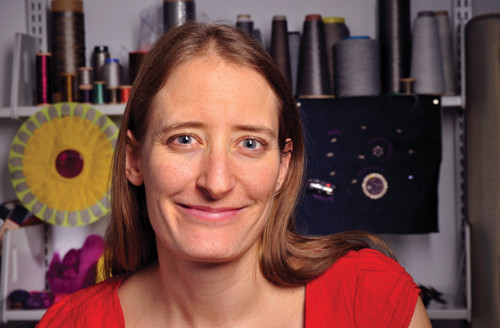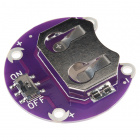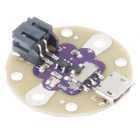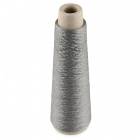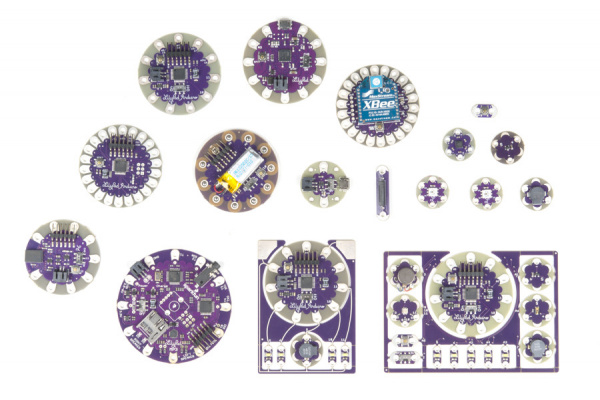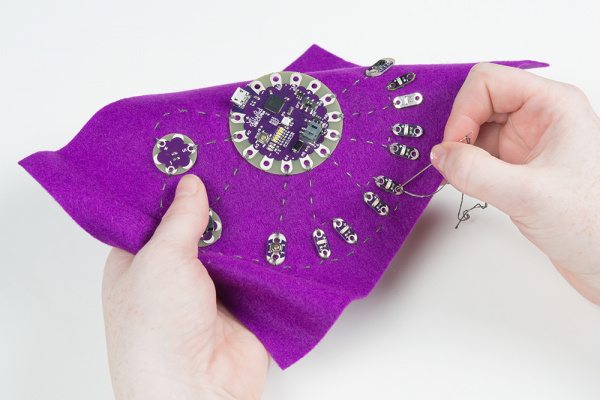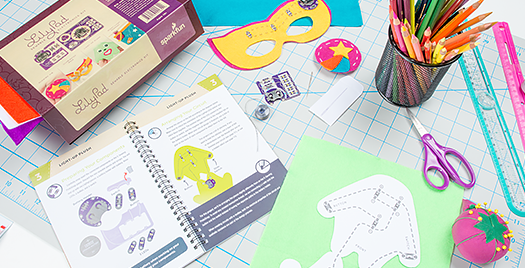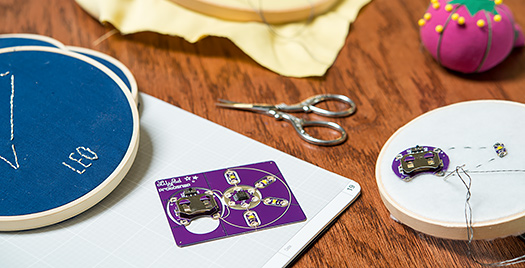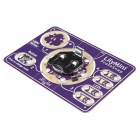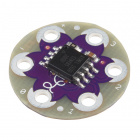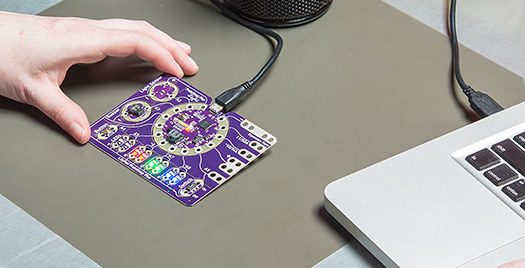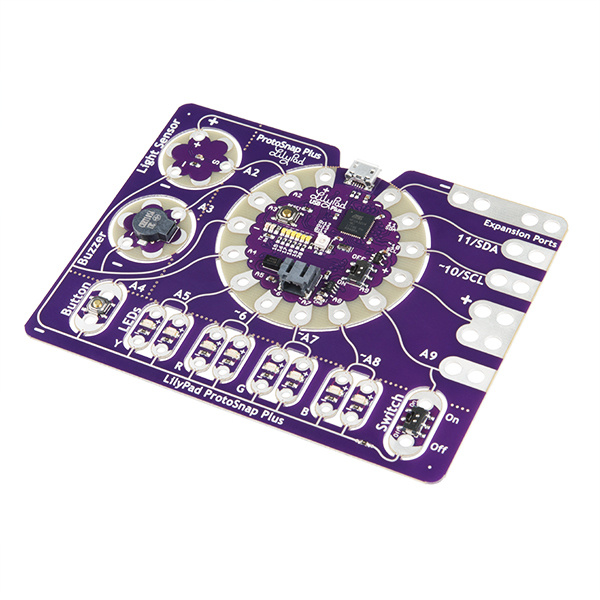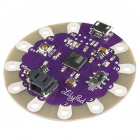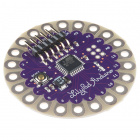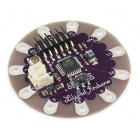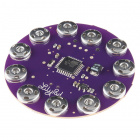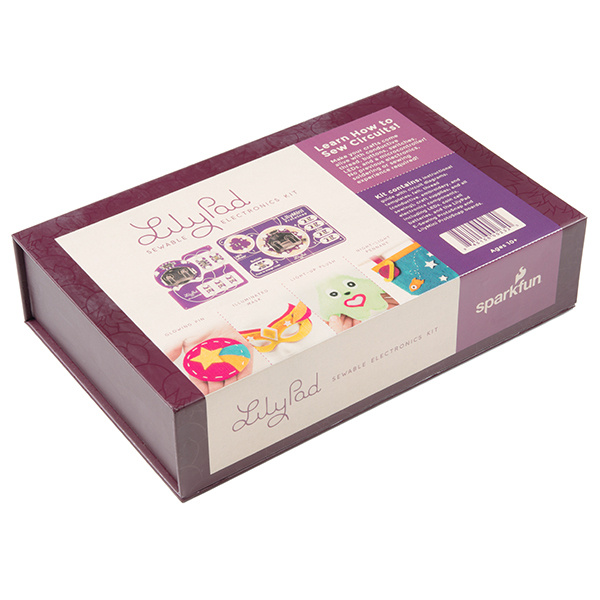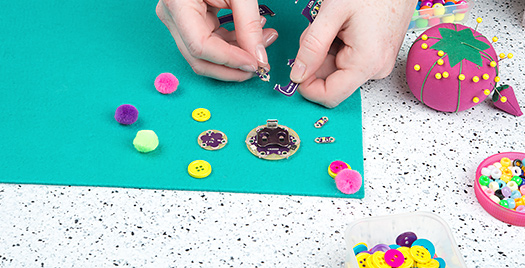Getting Started with LilyPad
Introduction
The LilyPad system is a set of sewable electronic pieces designed to help you build soft, sewable, interactive e-textile (electronic textile) projects. Using LilyPad pieces is a great way to experiment with electronics through the lens of crafting or fiber arts. Each LilyPad piece has large conductive sew tabs for easy sewing and a rounded shape so as not to snag fabric or cut thread. In this guide, we will walk you through features of the LilyPad system and some general concepts.
The LilyPad system was designed by Leah Buechley while pursuing her Ph.D. in computer science at the University of Colorado Boulder. The commercial version of the kit, which launched in 2007, was collaboratively designed by Leah and SparkFun Electronics.
LilyPad Basics: Parts of a Circuit
Every LilyPad circuit, no matter how complex, has three basic parts: (1) a power source, (2) conductive paths (conductive thread stitching) between electronic components, and (3) the LilyPad pieces that are connected together to light up, make sound or perform other behaviors (the “function” of your project).
1. Choosing a Power Source
All LilyPad projects need a power source — most use either a 3V CR2032 coin cell battery or a 3.7V lithium polymer rechargeable battery. Which power solution you need will depend on a few factors: the size of your project, the type of LilyPad Arduino you choose, and whether you would rather replace or recharge a battery. The LilyPad line includes a stand-alone sewable coin cell holder or built-in battery connections for 3V coin cell batteries or 3.7V lithium polymer batteries (available on select LilyPad boards).
2. Conductive Thread Connections
LilyPad boards are made to be sewn together using conductive thread, a special thread made with stainless steel fibers. Used instead of copper wiring to connect LilyPad pieces together, conductive thread provides a soft and flexible connection between components that is incorporated directly into fabric. Each LilyPad piece has a large sew tab to accommodate a variety of needle sizes for attaching conductive thread.
Learn more about sewing with conductive thread in the Lilypad Basics: E-Sewing tutorial.
LilyPad Basics: E-Sewing
3. LilyPad Pieces
The LilyPad line includes a variety of sewable components for creative projects. Choose from LEDs in a variety of colors, buttons, switches, sensors, buzzers, and controller (Arduino) boards. Check out all of the individual LilyPad pieces here. Which pieces you choose to build into your project will depend on your individual vision and goals. Read on for more about the different types of LilyPad projects you can make.
Types of LilyPad Projects
LilyPad projects can be divided into three main categories: (1) e-sewing, (2) pre-programmed, and (3) programmed with Arduino. Read the next few sections for more details on each project type.
E-Sewing
A great way to try out sewing with conductive thread without programming is to create e-sewing projects.
LilyPad LEDs and a LilyPad Coin Cell Battery Holder will light up a project, and the possibilities can be expanded to include simple interactive elements like buttons or switches, which you can purchase or make yourself. We recommend e-sewing projects if you are new to sewing or want to create a quick and easy light-up craft.
Here are some e-sewing projects to try:
Light-Up Plush
Glowing Pin
Illuminated Mask
Suggested Materials:
- Needle
- Scissors
- Felt or Fabric
- Hot Glue and Glue Gun
- Conductive Thread
- Coin Cell Battery
- LilyPad Coin Cell Battery Holder
- LilyPad LEDs
- Optional: LilyPad Button Board, LilyPad Slide Switch, metal snaps, conductive thread
Pre-Programmed Circuits
If you are ready to try some flashier effects with LEDs or explore how programmed projects work without writing the code yourself, pre-programmed LilyPad boards are a great option.
The LilyPad line includes four products that are project-ready: the LilyTiny, LilyTwinkle, LilyTwinkle ProtoSnap and LilyMini ProtoSnap — just sew and glow!
LilyTwinkle ProtoSnap
DEV-11590The LilyTiny and LilyTwinkle are small LilyPad boards with pre-loaded programs on them. Just hook them up to a LilyPad Coin Cell Battery Holder and some LilyPad LEDs to see different light patterns display on the LEDs. Both the LilyTiny and LilyTwinkle use the same circuit board and controller, but differ in the code they ship with.
LilyTiny
The LilyTiny has a different light pattern programmed for each numbered sew tab. Tab 0 controls a “breathing” fade, tab 1 flashes a heartbeat pattern, tab 2 creates an on/off blink, and tab 3 produces a random fading effect (twinkle). The LilyTiny is a great way to try out different light patterns in a project.
Try checking out a demo of the LilyTiny below.
Here are some LilyTiny projects to try:
LDK Experiment 6: Microcontroller Circuits
LilyTiny Plush Monster
Twinkle Zodiac Constellation
Suggested Materials:
- Needle
- Scissors
- Felt or Fabric
- Hot Glue and Glue Gun
- Conductive Thread
- LilyTiny
- LilyPad Coin Cell Battery Holder
- Coin Cell Battery
- LilyPad LEDs
LilyTwinkle
If you are looking for an overall sparkling effect on a project, the LilyTwinkle has all four numbered tabs programmed with a random fading effect, mimicking twinkling stars or fireflies. The LilyTwinkle also comes in a LilyTwinkle ProtoSnap, a pre-wired board containing everything you need to test and sew a LilyTwinkle project.
Try checking out a demo of the LilyTwinkle below.
Here are some LilyTwinkle projects to try:
Soft Circuits: LED Feelings Pizza
Firefly Jar Assembly Guide
Twinkling Trick or Treat Bag
Suggested Materials:
- Needle
- Scissors
- Felt or Fabric
- Hot Glue and Glue Gun
- Conductive Thread
- LilyTwinkle or LilyTwinkle ProtoSnap
- LilyPad Coin Cell Battery Holder (included if using ProtoSnap)
- Coin Cell Battery (included if using ProtoSnap)
- LilyPad LEDs (included if using ProtoSnap)
LilyMini ProtoSnap
For something more interactive, try the LilyMini ProtoSnap — a pre-wired, pre-programmed LilyPad board with a LilyPad Light Sensor and LilyPad Button attached to it. The LilyMini includes a built-in coin cell battery holder to eliminate additional sewing. Test out the circuit with the pre-wired connections, then snap apart and sew into a project. The LilyMini ProtoSnap has three pre-programmed modes (indicated by a built-in RGB LED): white (all LEDs on), magenta (LEDs fade in and out in a “breathing” pattern with speed affected by covering the light sensor), and cyan (when the light sensor is covered, LEDs twinkle).
Here are some LilyMini projects to try:
LilyMini ProtoSnap Hookup Guide
Night-Light Pennant with LilyMini ProtoSnap
Suggested Materials:
- Needle
- Scissors
- Felt or fabric
- Hot Glue and Glue Gun
- Conductive Thread
- LilyMini ProtoSnap (includes Coin Cell Battery)
Programmed with Arduino
Have an idea for a custom project and ready to program? The LilyPad line has a variety of LilyPad Arduino microcontrollers to choose from, all compatible with free Arduino software.
The LilyPad ProtoSnap Plus is a great place to start prototyping a project — it includes seven LilyPad boards pre-wired to a LilyPad microcontroller for experimenting with code before you sew.
The LilyPad ecosystem also includes four stand-alone LilyPad controllers, the LilyPad Arduino USB, LilyPad Arduino 328 Main Board, LilyPad Arduino Simple Board, and LilyPad Arduino SimpleSnap. These controller boards can be connected to most of the LilyPad boards for light-up, sound-making, or sensing projects.
LilyPad Arduino Simple Board
DEV-10274LilyPad Arduino SimpleSnap
DEV-10941Check out Choosing a LilyPad Arduino for Your Project for a side-by-side comparison of each board’s features.
Choosing a LilyPad Arduino for Your Project
Resources and Going Further
Start with a Kit
The LilyPad Sewable Electronics Kit — Includes everything you need to make 4 e-sewing projects: glowing pin, illuminated mask, light-up plush, and night-light pennant (with LilyMini). Craft supplies also included.
Plan Your Project
Check out Planning a Wearable Electronics Project for tips on brainstorming and prototyping, as well as technical considerations.
Planning a Wearable Electronics Project
Get Inspired
Take a look at our LilyPad Project Gallery to browse projects made with LilyPad or read some of SparkFun’s blog posts on LilyPad and wearables.
